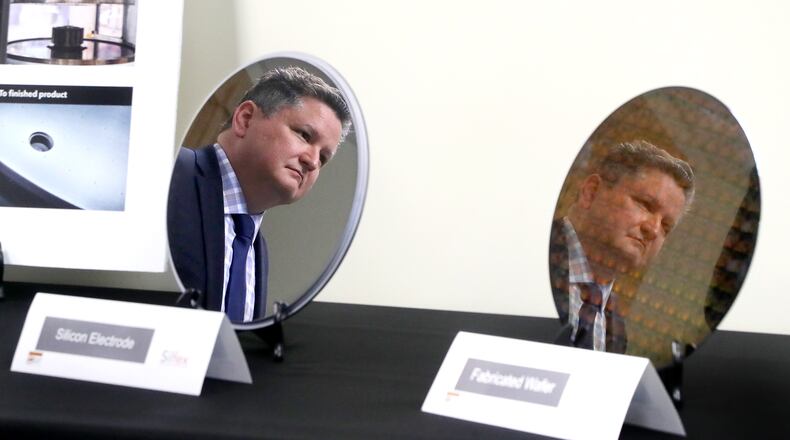During the crisis period of the pandemic when microchips were in high demand, the company was at 100% capacity, but now it is operating at about 50%, general manager Rob Skrobak said Tuesday.
Skrobak presented at an event hosted Tuesday by the Greater Springfield Partnership, focusing on development and business in the area. Various community leaders, including elected officials, nonprofit chairs and others involved in local government, attended the downtown Springfield luncheon.
Microchips are used in technology including cell phones, computers, gaming consoles, medical equipment, cars and some home appliances. They take about two to three months to produce, and there are almost 1,000 steps in the process, Skrobak said.
Silfex employs about 1,000 people across its Eaton and Springfield locations, communications manager Kate Seegraves said.
Credit: Bill Lackey
Credit: Bill Lackey
When asked if the capacity increase will affect the workforce, Seegraves said that the company assesses “our business operations on an ongoing basis, and will continue to make strategic decisions regarding our workforce as needed to best serve our customers.”
The pandemic “really highlighted” the importance of semiconductors in the world, Skrobak said, and Silfex ramped up its production to support an increased demand. With less demand, production decreased to about 50% in Springfield, but demand is expected to increase and production should ramp up to about 85% capacity by the end of 2025.
Silfex came to a 350,000-square-foot warehouse located on Titus Road in Springfield, near the PrimeOhio Industrial Park, in 2018. It received an incentive package with the Ohio Tax Credit Authority, which requires it to maintain operations at the Springfield location for at least 10 years and maintain an annual average payroll of $20.7 million.
Skrobak said that the semiconductor industry is expected to have a global and community impact of $1 trillion by 2030.
Silfex specifically has about $430 million in capital investments, and more than 300 machines on site, Skrobak said. The investment is expected to continue to grow.
The company’s role in the manufacturing of semiconductor chips is important, Skrobak said, being involved in the etching and source and support processes.
Silfex starts its manufacturing process with raw polysilicon, which is then refined and melted, then formed into a crystal silicon ingot, Skrobak said. The ingot is then sliced with a wire saw, put into a CNC machine, lapped and polished, etched and cleaned then packaged.
“We are proud to be in Ohio and advancing the world’s technology,” Skrobak said.
About the Author


